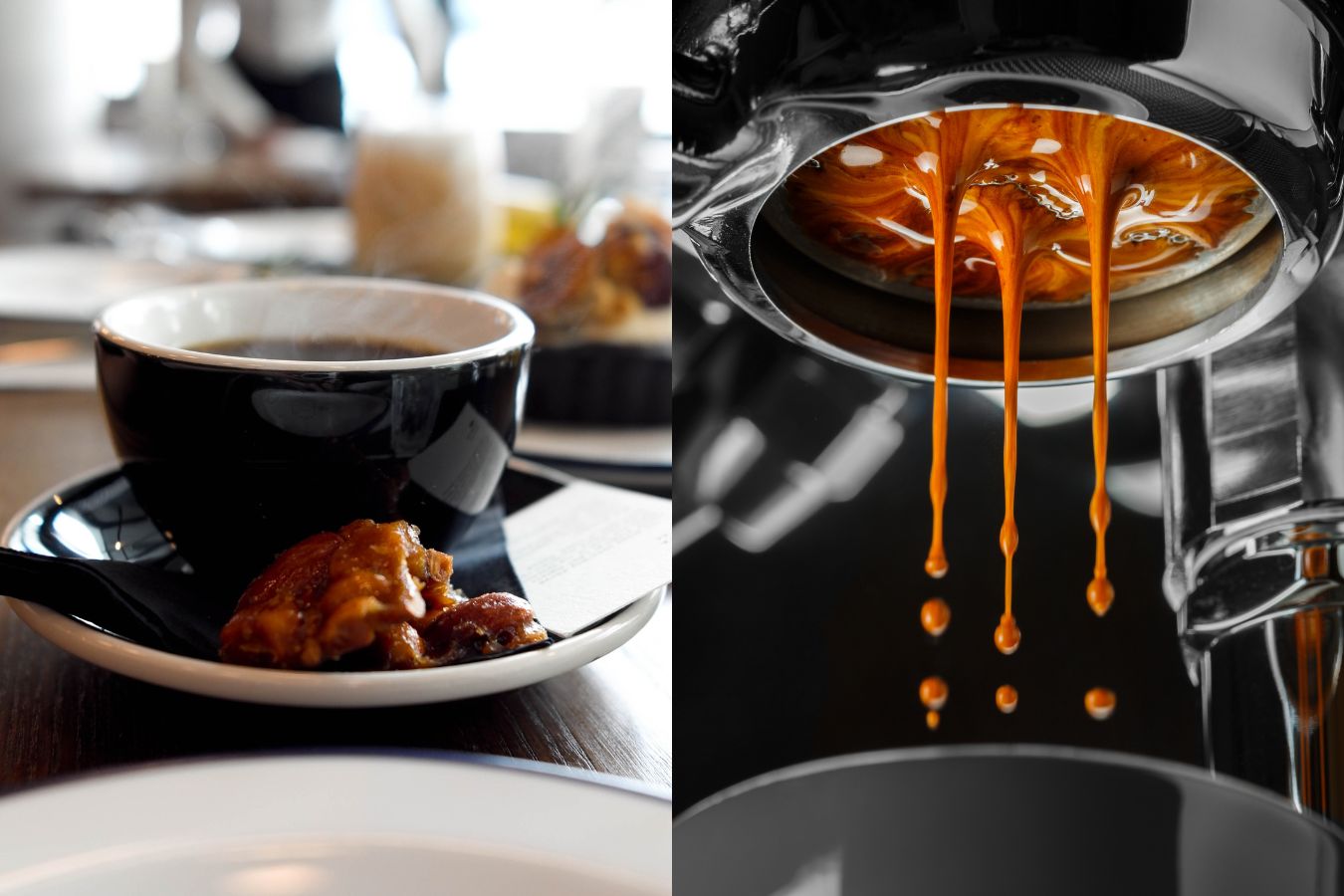Explore the Distinctive Flavor Profile of SOE Single Origin Espresso Today
Explore the Distinctive Flavor Profile of SOE Single Origin Espresso Today
Blog Article
Coffee Beans 101: Whatever You Need to Understand About Espresso and Blended Coffee Beans
When it comes to coffee, recognizing the subtleties of coffee and combined beans can transform your daily mug. From the expanding procedure to roasting methods, every step plays a duty in your coffee experience.
Recognizing Coffee Beans: Varieties and kinds
When diving into the world of coffee, understanding the kinds and ranges of coffee beans is vital for every lover. Arabica beans are understood for their smooth, intricate tastes and lower high levels of caffeine material, making them a favored among coffee fanatics.
Within these species, you'll find different regional selections, each bringing special characteristics. For circumstances, Ethiopian Yirgacheffe provides brilliant floral notes, while Colombian beans give a well-balanced taste profile. As you explore, remember to pay focus to handling techniques like washed or all-natural, as they can considerably influence the last preference. By familiarizing on your own with these beans and their flavors, you'll raise your coffee experience and make more informed choices in your brewing journey.
The Growing Process: From Seed to Bean
When you discover the trip of coffee, all of it beginnings with seed choice strategies that set the foundation for quality. From there, cultivation and collecting play necessary duties in guaranteeing the beans thrive. Finally, handling techniques change those harvested cherries right into the coffee beans you like.
Seed Option Techniques
Choosing the ideal seeds is essential for producing top quality coffee beans, as it lays the foundation for the entire expanding procedure. Pay attention to the seed's age and storage conditions, as fresh seeds tend to sprout better. Consider the condition resistance of various ranges, as this can considerably affect your yield.
Farming and Harvesting
As you nurture your coffee seeds right into flourishing plants, recognizing the cultivation and harvesting procedure is vital for attaining the best taste and high quality. Start by planting your seeds in well-draining dirt, ideally in a shaded area to secure them from direct sunlight.
When it comes time to harvest, search for ripe cherries, which usually turn a vibrant red. Hand-picking is commonly the ideal technique to assure only the ripest cherries are selected. Timing is crucial; gathering also late or too early can affect the taste account of your beans. Embrace persistence and care, as this is where top quality begins.

Processing Techniques Described
When you have actually harvested your coffee cherries, the next crucial step is refining them to change those dynamic fruits into the beans you'll make. In the completely dry process, you spread out the cherries out in the sun to completely dry, permitting the fruit to ferment and present special flavors to the beans. Understanding these approaches is crucial to appreciating your coffee experience.
Roasting Techniques: Exactly How Taste Is Developed
When it comes to toasting coffee beans, comprehending roast levels is key to exposing their one-of-a-kind flavors. Each toasting strategy impacts the scent and improves the taste advancement process, giving you a richer coffee experience. Allow's explore just how these aspects come with each other to elevate your everyday brew.
Roast Levels Clarified
Roast levels play an essential role in forming the taste account of your coffee. By understanding these degrees, you can much better pick a coffee that matches your preference preferences. Experiment with different roasts to discover which one reverberates with you, boosting your general coffee experience and satisfaction.
Influence On Aroma
The roast degree not only affects the preference of your coffee yet likewise significantly impacts its fragrance. Each toasting method releases various unstable compounds, shaping exactly how your coffee smells. Furthermore, the freshness of the beans plays a critical duty; newly roasted coffee launches more fragrant oils, enhancing that tempting fragrance.
Flavor Advancement Refine
As you explore the flavor growth procedure, you'll discover that roasting methods play a crucial role in forming the preference account of your coffee. The toasting temperature level and time straight affect the acidity, sweet taste, and bitterness of the beans. Light roasts maintain even more of the bean's initial tastes, highlighting flower and fruity notes.
Coffee vs. Blended Coffee: Key Differences
Coffee and combined coffee each offer unique experiences that deal with various tastes and choices. Coffee is a concentrated coffee brewed by requiring warm water with finely-ground coffee beans, resulting in a rich, strong taste and a velvety layer of crema ahead. It's frequently appreciated as a shot or made use of as a base for beverages like coffees and lattes.
On the other hand, combined coffee combines different beans from various regions, developing an extra balanced taste profile. You'll commonly locate blends that highlight body, level of acidity, or sweet taste, making them versatile for various brewing techniques. While coffee concentrates on strength, blended coffee may provide a more comprehensive variety of flavors that can change with each sip.
Inevitably, your selection in between espresso and combined coffee boils down to your individual choice. Whether you yearn for a quick shock or a leisurely mug, both alternatives have something delicious to offer.

Brewing Approaches: Opening the Perfect Mug
When it concerns brewing coffee, discovering the right approach can change your experience and raise your mug. Each brewing method has its unique appeal and can greatly impact your coffee's flavor and fragrance. For example, utilizing a French press permits you to enjoy a abundant and full-bodied brew, while a pour-over technique offers a clean, brilliant cup with distinct tastes.
If you choose espresso, purchasing a top quality device can aid you grasp the art of drawing shots. Additionally, for comfort, a single-serve husk system uses speed without compromising preference.
Don't ignore chilly brew, which supplies a smooth, much less acidic coffee perfect for warm days. Explore various methods to uncover what reverberates with your taste. Each developing strategy opens a new globe of possibilities, so put in the time to check out and discover your perfect cup. Delighted brewing!
Tasting Notes: Determining Flavor Profiles
How can you really appreciate your coffee if you do not know what tastes to look for? Sampling notes are your guide to understanding the complex globe of coffee. Some coffees might leave a chocolatey or sugar aftertaste, while others may have an intense, tidy finish.
Consider the body of the coffee, as well; is it airy and light or thick and syrupy? Do not fail to remember acidity; a brilliant level of acidity can include liveliness, while a low level of acidity could give a smoother experience. By recognizing these flavor profiles, you'll strengthen your connection with each cup, making coffee sampling a delightful journey of exploration.

Tips for Choose and Storage Coffee Beans
Storing and selecting coffee beans correctly can considerably boost your developing experience. Beginning by selecting high-quality beans that suit your taste - SOE.
Once you have your beans, store them in an impermeable container to avoid direct exposure to dampness, light, and air. A dark, great area functions best, so stay clear of maintaining them in the refrigerator or freezer, as this can introduce wetness. Just grind the quantity you require to preserve freshness; whole beans retain flavor longer than pre-ground coffee.
Finally, try to use your beans within 2 to four weeks after opening for peak taste. Adhering to these ideas will ensure your coffee stays flavorful and enjoyable, boosting your everyday brew to brand-new elevations.
Frequently Asked Inquiries
The Length Of Time Do Coffee Beans Remain Fresh After Toasting?
Coffee beans remain fresh for regarding two weeks after roasting - SOE. You need to keep them in an impermeable container, Single Origin Espresso far from light and moisture. Afterwards, their flavor and fragrance begin to diminish considerably

Can I Mix Different Coffee Bean Varieties?
Absolutely, you can blend different coffee bean ranges! Exploring with blends can enhance tastes and create a distinct preference profile. Just make certain to stabilize the strengths and characteristics of each selection for the very best outcomes.
What Is the Perfect Work Size for Coffee?
For coffee, you'll desire a great grind size, concerning the appearance of salt. This enables optimal extraction, leading to a rich, delicious shot. Experiment a little bit to discover what matches your taste best!
Exactly How Does Elevation Affect Coffee Bean Taste?
Altitude impacts coffee bean taste by influencing the development rate and chemical composition. Greater elevations cause slower maturation, which improves level of acidity and complexity, providing your coffee a special and vibrant taste you will not fail to remember.
Exist Decaffeinated Variations of Coffee Beans?
Yes, there are decaffeinated versions of espresso beans. You can appreciate a rich espresso flavor without the high levels of caffeine kick. Simply look for "decaf" blends at your regional coffeehouse or specialized shop.
Coffee Beans 101: Everything You Need to Know Concerning Espresso and Blended Coffee Beans.
When diving right into the globe of coffee, recognizing the kinds and selections of coffee beans is important for every lover.When it comes to toasting coffee beans, recognizing roast levels is crucial to disclosing their one-of-a-kind tastes. Coffee is a focused coffee brewed by requiring hot water via finely-ground coffee beans, resulting in an abundant, bold flavor and a creamy layer of crema on top.On the other hand, blended coffee integrates different beans from different regions, creating a much more balanced flavor profile.
Report this page